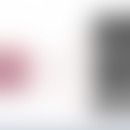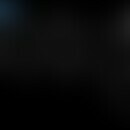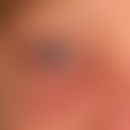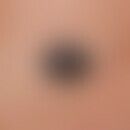Synonym(s)
DefinitionThis section has been translated automatically.
Non-malignant, non-inflammatory enlargement of the thyroid gland during normal (euthyroid) hormone production. An enlargement of the thyroid gland with a thyroid volume above the normal range for the sex and age of the patient is called goiter.
ClassificationThis section has been translated automatically.
Strumagrade according to WHO classification:
- Grade 0: The enlargement of the thyroid gland is neither palpable nor visible. Grade 0 can only be determined sonographically.
- Grade 1: Enlargement is palpable, but is not noticeable when looking at the neck.
- Grade 2: Enlargement of the thyroid gland is visible (visible thyroid enlargement from a volume > 40 ml).
You might also be interested in
Occurrence/EpidemiologyThis section has been translated automatically.
Thyroid enlargement and thyroid nodules were found in larger cross-sectional studies of the population in 35.9% of people with previously unknown thyroid (SD) disease. There is a clear correlation between the prevalence of goiter and nodules and the iodine supply of the population. A 5-year follow-up study showed a decrease in goiter and nodule prevalence after improved iodine supply (Völzke H et al. 2012).
EtiopathogenesisThis section has been translated automatically.
Intrathyroid iodine deficiency is the decisive factor in the pathogenesis of endemic goiter. This leads to activation of intrathyroid local growth factors (EGF, IGF) with proliferation of thyroid cells.
ManifestationThis section has been translated automatically.
w:m=1:1
ClinicThis section has been translated automatically.
Most strums cause no or only minor clinical symptoms. Avoiding necklaces, turtlenecks or an increase in collar size can be indications of a goiter.
Women are diagnosed with a thyroid gland volume >18ml, men with >25ml. Visibility is given from a volume of about 40 ml. In a surgical collective of clinically unremarkable patients, mechanical impairment due to tracheal and/or esophageal compression was present in 30 to 85% of patients. Clinical symptoms depend on the localisation of the goiter (dysphagia or dyspnoea often with retrosternal or retrotracheal growth) and the growth dynamics of the goiter (Hegedüs L et al. 2003).
ImagingThis section has been translated automatically.
Sonography (including Doppler sonography)
Sonographic findings such as a solid low-echo node, microcalcifications, an atypical intranodular vascularization pattern and a blurred borderline are present with an increased prevalence in SD malignancies. The specificity of the individual ultrasound parameters is low for the prediction of malignancy and should therefore not lead to an ultrasound-based "histological" diagnosis. If several suspicious ultrasound findings are detected in an SD node, an experienced examiner will achieve a sensitivity of 83-99 % and a specificity of 56-85 % for the presence of a thyroid malignoma (Frates MC et al. 2005).
Sonographic evaluation of malignancy criteria (Frates MC et al. 2005):
- Positive prediction = criterion for the presence of a thyroid carcinoma
- Negative prediction = exclusion of a thyroid carcinoma in the absence of the criterion
- Echo poverty: Positive prediction (74-94%); Negative prediction (11-68%)
- Microcalcifications: Positive prediction (42-94%); Negative prediction (24-71%)
- Fuzzy limitation (no halo effect): Positive prediction (86-97%); Negative prediction (24-42%)
- Anterior-posterior/transversal diameter >1: Positive prediction (75%); Negative prediction (67%)
In the case of multinodal goiter, the combination of sonography/scintigraphy and targeted fine needle aspiration biopsy allows the clarification of suspicious nodules (focusing on non-autonomous and cold areas with sonographically conspicuous findings).
Elastography
This method allows the detection of an indurated parenchymal area which is characterized by a reduced compressibility in elastography. (Bojunga J et al. 2010).
Importance of scintigraphy in the differential diagnosis of nodular goiter
Scintigraphically, (focal) autonomies can be detected early on. In order not to overlook SD autonomy, a basic scintigraphy is recommended once for nodes > 10 mm; this is independent of the TSH value. In the case of euthyroid metabolic status and scintigraphic evidence of a focally increased uptake (so-called warm nodule), a suppression scintigraphy is often required for further differentiation in order to distinguish volume artefacts (ratio of nodule size to thyroid lobe) from actual SD autonomy. If SD autonomy is proven, dignity assessment of the node is not necessary, since autonomous adenomas are usually benign (Gharib H et al.2010)
LaboratoryThis section has been translated automatically.
TSH, Calcitonin (exclusion of medullary thyroid carcinoma), (Karges W et al. (2004).
In the case of sonographic suspicion of an autoimmune thyroid thyroid disease, the determination of thyroid autoantibodies(anti-TPO-Ak, TSH receptor-Ak; thyroglobulin determinations are not indicated for goiter nodosa - Gharib H et al. 2010).
At the latest before a planned operation of a nodular goiter, a calcitonin determination should be performed once for the detection of a medullary thyroid carcinoma (Karges W et al. 2004).
HistologyThis section has been translated automatically.
Fine needle (aspiration) biopsy (FNB)
Method for the targeted removal of tissue cylinders or cell material from suspected thyroid nodules. The aim is to identify clinically inconspicuous, malignant tumour nodes at an early stage and to provide targeted therapy. In trained examiners, the FNB allows a high degree of accuracy in papillary, medullary, poorly differentiated and anaplastic thyroid carcinoma with a nodular goiter (Schmid KW et al. (2011).
According to current recommendations, the indication for FNB does not exist for every euthyroid, cold thyroid node, but only for thyroid nodes that are suspected of malignancy on the basis of sonographic criteria (e.g. solid, low-echo nodules with blurred edges; or nodules in patients with an increased risk of malignancy, e.g. as a result of external radiation or a positive family history). The puncture of nodules < 1.0 cm is performed by various surgeons. 1.0 cm is evaluated differently by different societies (low accuracy, low clinical significance for the patient (Führer D et al. 2010).
DiagnosisThis section has been translated automatically.
Diffuse goiter and nodose goiter:
Subtle anamnesis (previous irradiation of the head and neck region, thyroid carcinoma in the family, associated with an increased risk of thyroid malignancy), clinical presentation (duration and progression of thyroid enlargement); clarification of a possible thyroid dysfunction or compression symptoms (hoarseness, stress dyspnea and/or dysphagia?) Careful palpation of the thyroid gland allows an assessment of the extent of the goiter and clinical signs of malignancy (hard, non-swallowing nodules, enlarged cervical lymph nodes). It is important to differentiate between inflammatory thyroid diseases (e.g. touch sensitivity and pressure pain in subacute granulomatous thyroiditis de Quervain (Gharib H et al.2010) and to clarify potential thyroid autonomy?
By means of imaging procedures(sonography, elastography, scintigraphy) and, if necessary, histological confirmation differential diagnostic evaluation and assignment of the goiter; differentiation of inflammatory or neoplastic forms. Determination of thyroid-stimulating hormone (TSH) for the assessment of thyroid function.
Complication(s)(associated diseasesThis section has been translated automatically.
Tracheal complications (3 grades):
- Displacement of the trachea without constriction.
- Compression symptoms (e.g. stridor, influence congestion)
- Tracheomalacia (saber trachea)
Development of thyroid autonomy:
- Iodine-deficient goiter shows an increasing tendency to develop TSH-independent functional autonomy depending on the age of the goiter, the size of the goiter, and nodular transformation. In most cases, multifocal thyroid autonomy (of multiple autonomous districts) is found. In elderly patients with large nodular goiter, functional autonomy is found in >50%. Development of cold nodules (carcinoma risk 4%).
TherapyThis section has been translated automatically.
Therapy of euthyroid goiter with and without nodules
Basically 4 therapy concepts are possible:
- Option "wait and watch" (to be considered for asymptomatic patients).
- Conservative: drug treatment
- Surgical (depending on the findings: partial or total resection)
- Radiological (radioiodine therapy)
The decision for the respective therapy concept is made under consideration of individual patient characteristics, weighing up benefits and risks, availability and experience with the respective therapy procedures and the patient's wishes (Note: comparative studies on the different therapy concepts are largely lacking).
Diffuse euthyroid goiter
Iodide substitution (volume reduction of 10% achievable): Since iodine deficiency is the most important cause of euthyroid goiter diffusion, the correction of intrathyroid iodine deficiency is the primary treatment goal.
In children and adolescents before puberty the administration of iodide (150-200 µg iodide/d) is the therapy of choice (15). Iodide monotherapy (200ug/d, e.g. Iodetten Henning®) can also be successful in adolescents during puberty and in young adults (uncertain evidence base).
Combination therapy with iodide + LT4 (e.g. Thyranojodide Henning®)
Alternatively, iodide-levothyroxine combination therapy (ratio 2:1; for example, 150 µg iodide/75 µg levothyroxine) can be considered for adults, under which a volume reduction is achieved over a period of 12-18 months. This therapy is also the therapy of choice for pregnant women.
It is important to ensure that sufficient iodine is supplied after the end of therapy (Zimmermann MB 2009). TSH-suppressive therapy is obsolete, as is monotherapy of a diffuse goiter with levothyroxine, which leads to further intrathyroid iodine depletion and renewed thyroid growth as soon as the medication is discontinued.
Euthyroid goiter nodosa
Indication for therapy is mandatory in case of suspected malignancy and in case of compressive complications (data on the spontaneous course of euthyroid goiter is insufficient - Hegedüs L et al. 2003).
In the case of euthyroid (or latent hyperthyroid) thyroid autonomy the risk of manifestation of hyperthyroidism is about 4%. A risk for these patients arises in case of artificial iodine contamination (e.g. contrast medium or amiodarone). In a larger collective, 31 % of patients with euthyroid SD autonomy under yodexcess developed hyperthyroidism in the course of the disease.
SD autonomy should not only be treated in cases of (latent as well as manifest) hyperthyroidism, but also in cases of (still) euthyroid metabolism. This applies depending on the autonomy volume, especially for patients with comorbidities and increased probability of contrast agent exposure. The definitive treatment of SD autonomy is either surgical or radioiodine therapy (Paschke R et al. 2005).
Radiation therapyThis section has been translated automatically.
Radioiodine therapy
By means of radioiodine therapy, an efficient volume reduction can be achieved after one year, even with large and very large strumes (volumes of 100 to 300 ml), by about 35-40%, or by 40-60% after 2 years. At the same time possible improvement of compression symptoms.
Radioiodine therapy is thus clearly superior to a drug-induced SD volume reduction and represents an alternative to surgical struma therapy, especially in patients with speech (lack of risk of recurrent paresis) and in older patients with high comorbidity. Recurrence growth occurs after radioiodine therapy only very delayed observed. If the volume reduction is not sufficient, radioiodine therapy may be repeated (Fast S et al. 2010).
The extent of SD volume reduction correlates with
- the patient age
- struma duration (higher effectiveness in younger patients with less regressive changes)
- the struma size
- the therapeutic activity
- the homogeneity of iodine storage (Fast S et al. 2010).
Long-term side effects of radioiodine therapy in struma nodosa are hypothyroidism in need of substitution (22-58 % within 5-8 years after therapy) and in rare cases (< 5 %) the development of an immunothyroidism.
Advantages of radioiodine therapy: no anaesthesia and surgery required, few side effects, repetition possible without complications, with recombinant TSH even more effective in volume reduction (19).
Disadvantages of radioiodine therapy: longer inpatient stay than in thyroid surgery, delayed evidence of therapeutic success, moderate swelling, rarely painful radiation thyroiditis and hyperthyroidism in the course of cell decay, new manifestation of autoimmune hyperthyroidism. Later, regular follow-up examinations are necessary with regard to the development of hypothyroidism. After radioiodine therapy, lifelong follow-up is necessary with regard to the development of hypothyroidism. The rate of hypothyroidism depends on the type of disease and the applied radiation dose as well as the functional reserve of the healthy thyroid tissue before therapy. In the treatment of disseminated autonomy, hypothyroidism must be expected in 30% of patients after ten years (Dietlein M et al. 2007).
Internal therapyThis section has been translated automatically.
The euthyroid goiter nodosa (without autonomy) is usually treated with medication. However, the international data on the efficiency of this therapy is controversial. In a larger study (n=1 024 patients), patients with SD nodules/stria nodosa were treated for more than one year with a TSH-adapted levothyroxine (LT4) or LT4-iodide combination therapy compared to iodide or placebo (Grussendorf M et al. 2011).
- A nodal volume reduction of -21.6 % was achieved under LT4 iodide combination therapy compared to -5.2 % under placebo. The total thyroid volume was reduced by 10 % compared to -1.9 % on placebo.
- Node volume reduction of 12.6% was achieved with levothyroxine monotherapy.
- Nodal volume reduction of 9% was achieved with iodide monotherapy
A combination of LT4+iodide is the therapy of choice for pregnant women.
Advantages of drug therapy: low costs, no inpatient stays, no invasive procedure. Disadvantages of drug therapy: unclear mechanism of action, unclear data on long-term success, iatrogenic hyperthyroidism, decreasing compliance with long-term therapy, not useful in the case of a large nodular goiter.
Operative therapieThis section has been translated automatically.
Surgical therapy of the thyroid gland is obligatory in cases of suspected malignancy. Further indications are a retrosternal or mediastinal struma extension and uni- or multifocal thyroid autonomy.
For the surgical therapy of benign nodular goiter, a practice recommendation of the Surgical Working Group Endocrinology (CAEK) from 2011 is available (Musholt TJ et al. 2011). It contains information on indications, on the different SD resection methods (hemithyroidectomy, subtotal, almost complete -"near total" or total thyroidectomy) and on the risk of undesirable complications such as recurrent paresis, postoperative hypoparathyroidism). The frequency of postoperative recurrent paresis is estimated to be about 2.9% (transient recurrent paresis) and 0.7% (permanent recurrent paresis). It depends largely on the surgeon, the extent of the resection, the variables "initial or recurrent intervention" and the type of thyroid alteration (presence of an SD malignoma) (Musholt TJ et al. 2011). Another undesirable complication of SD surgery is permanent postoperative hypoparathyroidism, which is associated with significant morbidity (tetanus, hypercalcemic crisis, end organ damage due to calcium deposition). Here incidences between 0.5 and 1.6% are given (Musholt TJ et al.2011).
After SD surgery, the need for SD hormone substitution should be reviewed, depending on the residual tissue remaining in situ. After "near total" or total thyroidectomy a body weight-adapted levothyroxine substitution (1.6-1.8 µg LT4/kg body weight) should be started immediately postoperatively. Since iodine deficiency is the most important avoidable cause of goiter, LT4 substitution can be performed in combination with iodide.
Advantages of the surgical procedure: rapid elimination of mechanical complaints and SD autonomy, securing of the diagnosis by histological evaluation.
Disadvantages of the surgical procedure: in-patient stay, possible complicated recurrent paresis, hypoparathyroidism. Possible lifelong SD hormone substitution.
AftercareThis section has been translated automatically.
If conservative treatment (waiting, drug therapy) of the benign diffuse and nodosa goiter is carried out, follow-up examinations should be carried out at 6-18-month intervals under the following conditions:
- Have changes in the SD volume occurred?
- Has the size and morphology of existing nodules in the nodose goiter changed or have new nodules appeared?
- Has there been a change in SD function, for example, hyperthyroidism after exposure to contrast medium with pre-existing undetected SD autonomy or hypothyroidism in autoimmune thyroiditis in a nodose goiter?
In addition to taking the patient's medical history and clinical examination, sonographic monitoring and a TSH determination are usually sufficient. In case of changes in the findings, a specific diagnosis should be made, analogous to the initial evaluation of the diffuse goiter and multinodal goiter.
LiteratureThis section has been translated automatically.
- Bojunga J et al (2010) Real-time elastography for the differentiation of benign and malignant thyroid nodules: a meta-analysis. Thyroid 20: 1145-1150.
- Dietlein M et al (2007) Guideline for radioiodine therapy for benign thyroid diseases (4th version). Nuclear medicine 46: 220-223.
- Fast S et al (2010) Recombinant human thyrotropin-stimulated radioiodine therapy of nodular goiter allows major reduction of the radiation burden with retained efficacy. J Clin Endocrinol Metab 95: 3719-3725.
- Frates MC et al (2005) Management of thyroid nodules detected at US: Society of Radiologists in Ultrasound consensus conference statement. Radiology 237: 794-800.
- Führer D et al. (2012) Euthyroid goiter with and without nodules - diagnostics and therapy. Dtsch Arztebl Int 109: 506-516
- Guide D et al (2010) Benign thyroid nodule or thyroid cancer? Internist 51: 611-619.
- Gharib H et al (2010) Medical guidelines for clinical practice for the diagnosis and management of thyroid nodules: Executive Summary of recommendations. AACE/AME/ETA Task Force on Thyroid Nodules. J Endocrinol Invest 33: 287-291
- Grussendorf M et al (2011) Reduction of thyroid nodule volume by levothyroxine and iodine alone and in combination: A randomized, placebo-controlled trial. J Clin Endocrinol Metab 96: 2786-2795.
- Hegedüs L et al (2003) Management of simple nodular goiter: current status and future perspectives. Endocr Rev 24: 102-132.
- Karges W et al (2004) Calcitonin measurement to detect medullary thyroid carcinoma in nodular goiter: German evidence-based consensus recommendation. German Society for Endocrinology (DGE) - Thyroid Section. Exp Clin Endocrinol Diabetes 112: 52-58.
- Musholt TJ et al(2011) German Association of Endocrine Surgeons practice guidelines for the surgical treatment of benign thyroid disease. Interdisciplinary task force guidelines of the German Association of Endocrine Surgeons. Langenbeck's Arch Surgery 396: 639-649.
- Paschke R et al (2005) Recommendations and unanswered questions in the diagnosis and treatment of thyroid nodules. Opinion of the Thyroid Section of the German Society for Endocrinology. Dtsch Med Wochenschr 130: 1831-1836.
- Schmid KW et al (2011) When is fine needle biopsy of the thyroid gland most effective? The pathologist 32: 169-172.
- Völzke H et al (2003) The prevalence of undiagnosed thyroid disorders in a previously iodine-deficient area. Thyroid 13: 803-10.
- Völzke H et al (2012) Five-year change in morphological and functional alterations of the thyroid gland-the study of health in Pomerania. Thyroid 22:737-746. https://www.ncbi.nlm.nih.gov/pubmed/22663551
- Zimmermann MB (2009): Iodine deficiency. Endocr Rev 30: 376-408.
Outgoing links (11)
Amiodarone; Anti-tpo antibody; Calcitonin; Hyperthyroidism; Hypoparathyroidism; Immunogenic hyperthyroidism; Sonography, 5-10 mhz sonography; Subacute granulomatous thyroiditis de quervain; Thyroglobulin; Thyroid autonomy; ... Show allDisclaimer
Please ask your physician for a reliable diagnosis. This website is only meant as a reference.




